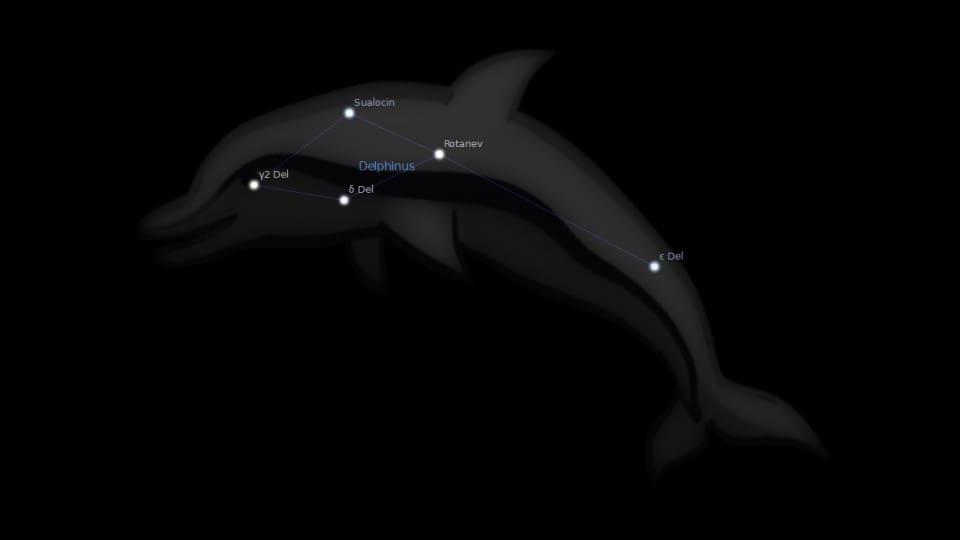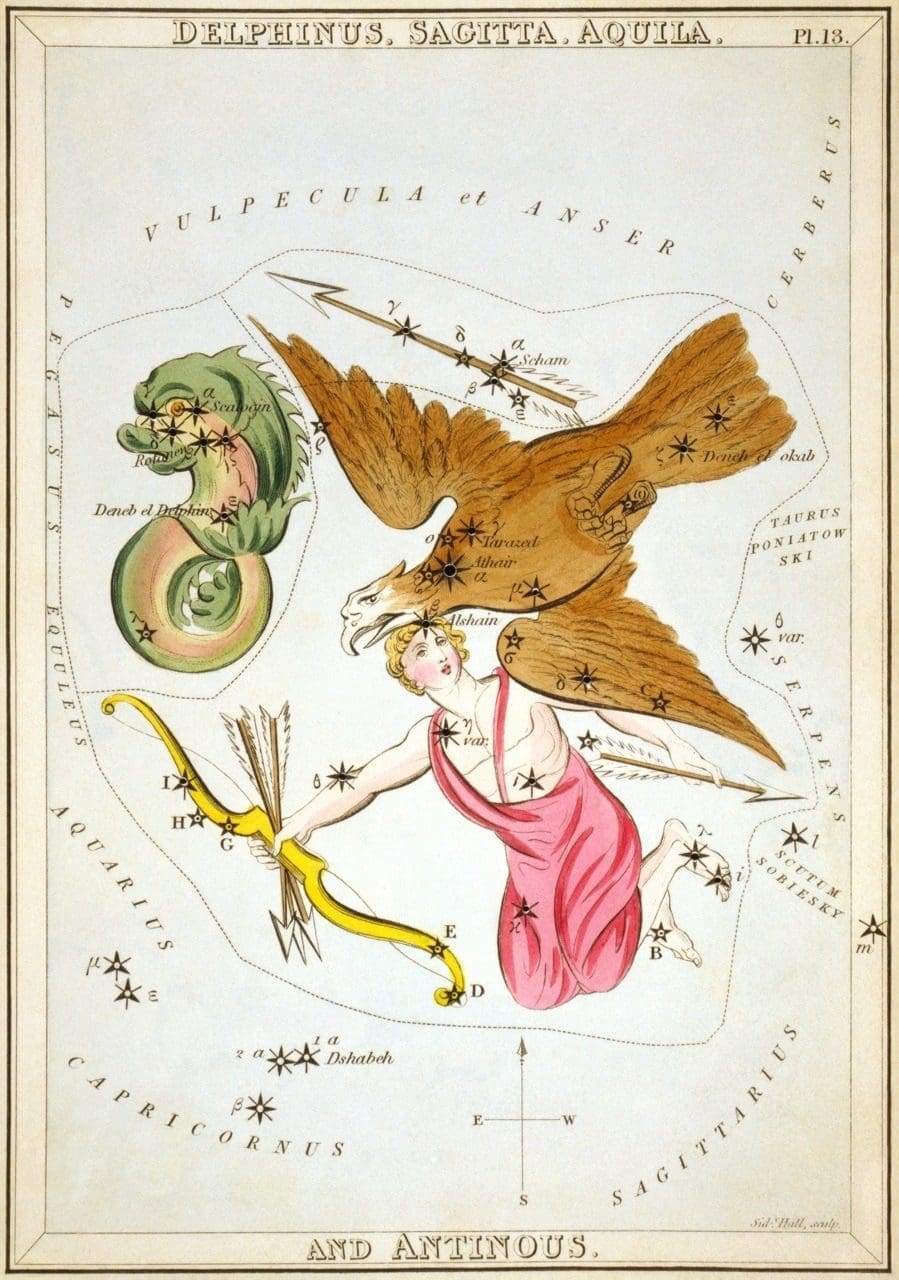In Chinese astronomy, the stars of Delphinus are located within the Black Tortoise of the North (北方玄武, Běi Fāng Xuán Wǔ).
| 2000 | B | Star | Mag | Orb |
|---|---|---|---|---|
| 14 ♒ 03 | ε | Aldulfin | 4.0 | 1°00′ |
| 15 ♒ 14 | κ | Kappa Del | 5.1 | 1°00′ |
| 15 ♒ 44 | ζ | Zeta Del | 4.6 | 1°00′ |
| 16 ♒ 19 | β | Rotanev | 3.6 | 1°20′ |
| 17 ♒ 22 | α | Sualocin | 3.8 | 1°10′ |
| 18 ♒ 06 | δ | Al Ukud | 4.4 | 1°00′ |
| 19 ♒ 21 | γ2 | Al Salib | 4.3 | 1°00′ |
Delphinus Constellation Astrology
In astrology, Delphinus is like Saturn and Mars. It gives a simple appearance, cheerfulness, dissembling and duplicity, love of hunting, and sport in general but little happiness. There is a fondness for pleasure, ecclesiastical matters and travel, but danger of suffering from ingratitude. [1]
Delphinus or the constellation of the Dolphin is the sky emblem of philanthropy and its bright stars are of the nature of Mercury and Jupiter, although there are others as Saturn and Mars. It denotes an individual devoted to his children and of a very religious nature. The Martian element manifests itself in love of hunting and sport, while that of Saturn portends a difficulty in finding true happiness. In judicial astrology the constellation presages good fortune in regards the sea. [2]
Delphinus Rising
The sea-dark Dolphin ascends from the Ocean to the heavens and emerges with its scales figured by stars, birth is given to children who will be equally at home on land and in the sea. For just as the dolphin is propelled by its swift fins through the waters, now cleaving the surface, now the depths below, and derives momentum from its undulating course, wherein it reproduces the curl of waves, so whoever is born of it will speed through the sea. Now lifting one arm after the other to make slow sweeps he will catch the eye as he drives a furrow of foam through the sea and will sound afar as he thrashes the waters; now like a hidden two-oared vessel he will draw apart his arms beneath the water; now he will enter the waves upright and swim by walking and, pretending to touch the shallows with his feet, will seem to make a field of the surface of the sea; else, keeping his limbs motionless and lying on his back or side, he will be no burden to the waters but will recline upon them and float, the whole of him forming a sail-boat not needing oarage.
Other men take pleasure in looking for the sea in the sea itself: they dive beneath the waves and try to visit Nereus and the sea nymphs in their caves; they bring forth the spoils of the sea and the booty that wrecks have lost to it, and eagerly search the sandy bottom.
From their different sides swimmers and divers share an equal enthusiasm for both pursuits, for their enthusiasm, though displayed in different ways, springs from a single source.
With them you may also reckon men of cognate skill who leap in the air, thrown up from the powerful spring-board, and execute a see-saw movement, the first’s descent throwing up the second and the plunge of the second lifting the first on high; or hurl their limbs through the fire of flaming hoops, imitating the dolphin’s movement in their flight through space, and land as gently on the ground as they would in the watery waves: they fly though they have no wings and sport amid the air.
Even if the Dolphin’s sons lack these skills, they will yet possess a physique suited to them; nature will endow them with strength of body, briskness of movement, and limbs which fly over the plain. [3]
Delphinus Mythology
When Amphitrite, who was sought as a wife by Neptune, hid herself, the God sent messengers to find her. The dolphin was the first to succeed and persuaded her to consent to the marriage, for which service Neptune placed him in the heavens. According to other accounts it is one of the pirates who were changed into dolphins by Bacchus on his voyage to Ariadne. [1]
In Greece it also was Ieros Ikhthus, the Sacred Fish, the creature being of as much religious significance there as a fish afterwards became among the early Christians; and it was the sky emblem of philanthropy, not only from the classical stories connected with its prototype, but also from the latter’s devotion to its young. It should be remembered that our stellar Dolphin is figured as the common cetacean, Delphinus delphis, of Atlantic and Mediterranean waters, not the tropical Coryphaena that Dorado represents.
Ovid, designating it as clarum sidus, personified it as Amphitrite, the goddess of the sea, because the dolphin induced her to become the wife of Neptune. [4]
Men admire women for their devotion to their children, yet I observe that mothers whose sons or whose daughters have died, continued to live and in time forget their sufferings, their grief having abated. But the female Dolphin far surpasses all creatures in its devotion to its offspring. It produces two. . . . And when a fisherman either wounds a young dolphin with his harpoon or strikes it with his barb . . . The barb is pierced at the upper end, and a long line is fastened to it, while the barbs sink in and hold the fish. So long as the wounded Dolphin still has any strength, the fisherman leaves the line slack, so that the fish may not break it by violence, and so that he himself may not incur a double misfortune through the Dolphin escaping with the barb and himself failing to catch anything. As soon as he perceives that the fish is tiring and is somewhat weakened by the wound, he gently brings his boat near and lands his catch. But the mother Dolphin is not scared by what has occurred nor restrained by fear, but by a mysterious instinct follows in her yearning for the child. And though one confront her with with terrors never so great, she is still dismayed, and will not endure to desert her young one which has come to a bloody end; indeed, it is even possible to strike her with one hand, so close does she come to the hunters, as though she would beat them off. And so it comes about that she is caught along with her offspring, though she could save herself and escape. But if both her offspring are by her, and if she realizes that one has been wounded and is being hauled in, as I said above, she pursues the one unscathed and drives it away, lashing her tail and biting her little one with her mouth; and she makes a blowing sound as best she can, indistinct, but giving the signal to flee, which saves it. So the young Dolphin escapes, while the mother remains until she is caught and dies along with the captive. [5]
References
- Fixed Stars and Constellations in Astrology, Vivian E. Robson, 1923, p.43.
- Fixed Stars and Judicial Astrology, George Noonan, 1990, p.28.
- Astronomica, Manilius, 1st century AD, p.335.
- Star Names: Their Lore and Meaning, Richard H. Allen, 1889, p.200.
- De Natura Animalium, Claudius Aelianus (175 – 235 AD), 1.18.

